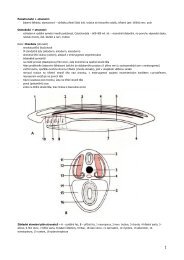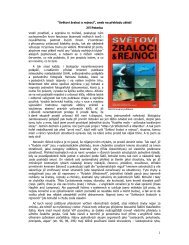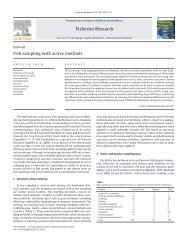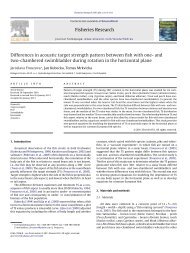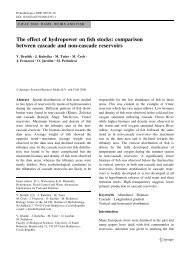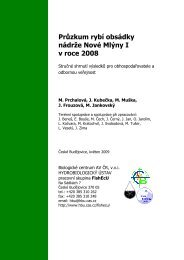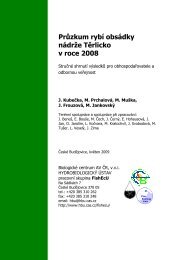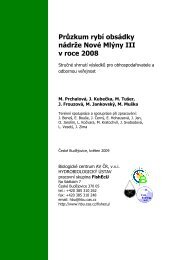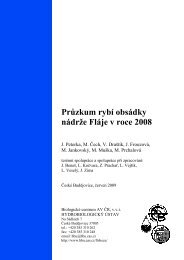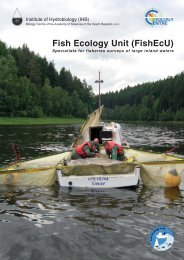proportion <strong>of</strong> larger individuals. These population oscillations were expected and are characteristic for the species in the reservoir. The results <strong>of</strong> sampling in the year 2010 well fitted into the long-term development <strong>of</strong> the fish stock <strong>of</strong> Římov Reservoir [2]. [1] Říha, M., Kubečka, J., Mrkvička, T., Prchalová, M., Čech, M., Draštík, V., Frouzová, J., Hladík, M., Hohausová, E., Jarolím, O., Jůza, T., Kratochvíl, M., Peterka, J., Tušer M., and Vašek, M. (2008): Dependence <strong>of</strong> beach seine net efficiency on net length and diel period. Aquatic Living Resources, 21(4): 411–418. [2] Říha, M., Kubečka, J., Vašek, M., Seďa, J., Mrkvička, T., Prchalová, M., Matěna, J., Hladík, M., Čech, M., Draštík, V., Frouzová, J., Hohausová, E., Jarolím, O., Jůza, T., Kratochvíl, M., Peterka, J., and Tušer, M. (2009): Long-term development <strong>of</strong> fish populations in the Římov Reservoir. Fisheries Management and Ecology 16: 121–129. 3.4 The effect <strong>of</strong> river water circulation on the distribution and functioning <strong>of</strong> reservoir microbial communities as determined by a relative distance approach K. Šimek (ksimek@hbu.cas.cz), J. Nedoma, M. Comerma, J.-C. Garcia, J. Armengol, and R. Marce (Department <strong>of</strong> Ecology, University <strong>of</strong> Barcelona, Spain) collaborated on a research project dealing with the factors shaping longitudinal gradients modulated by different circulation patterns in the eutrophic reservoir Sau, Catalonia, Spain. The reservoir is characterized as showing: (I) high nutrient and organic matter inputs; (II) morphology typical for a deep and narrow river valley reservoir; and (III) a typical water residence time <strong>of</strong> ~90 days. Thus, we anticipated finding clear longitudinal patterns and relationships between limnological and biological parameters along the reservoir even over different seasons <strong>of</strong> a year. We hypothesized that development and the maxima <strong>of</strong> bacterial, heterotrophic nan<strong>of</strong>lagellates (HNF) and ciliate communities, and thus organic carbon processing, are directly related to the proportion <strong>of</strong> nutrients and organic matter rich river water that is mixed into the reservoir epilimnion. To test these hypotheses, we analyzed 8 sampling campaigns conducted between 1996 and 1999 covering all seasonal aspects <strong>of</strong> the hydrology <strong>of</strong> the reservoir i.e., covering a wide range <strong>of</strong> variability in both seasonal and spatial circulation patterns. Then the spatial heterogeneity was examined using a relative distance model that allows standardization <strong>of</strong> the typical patterns in plankton succession under different hydrological situations (cf. Figs. 1 and 2). Study aims were [1]: (a) to propose a general method that allows for the comparison and prediction <strong>of</strong> common trends in the spatial dynamics <strong>of</strong> plankton communities and their functioning under different hydrological scenarios in canyon shaped reservoirs; and (b) to specifically analyze the influence <strong>of</strong> overflow events on organic carbon processing and oxygen saturation levels <strong>of</strong> the epilimnetic layer <strong>of</strong> the Sau Reservoir. To objectively compare the biological longitudinal gradients under seasonally fluctuating water levels and different types <strong>of</strong> water circulation patterns, we applied a model based on the relative distance <strong>of</strong> a sampling station from the river inflow (Fig. 1). Even under different hydrological scenarios, the model was able to characterize epilimnetic food chain successions and locations <strong>of</strong> peaks <strong>of</strong> bacteria, heterotrophic nan<strong>of</strong>lagellates, ciliates, phytoplankton, and zooplankton along the longitudinal gradient (Fig. 2). The amplitude <strong>of</strong> microbial peaks was directly related to the proportion <strong>of</strong> nutrient and organic carbon rich river water that mixed into the reservoir epilimnion. Enhanced abundances and activities <strong>of</strong> microbes were detected 20
Fig. 1: A – Schematic drawing <strong>of</strong> water circulation patterns, i.e. over-, inter- and underflow, in deep canyon shaped reservoirs. Depending on water temperature and water quality parameters river water masses plunge to different strata <strong>of</strong> the reservoir. Downstream from the plunge point a transient mixing zone starts with a very strong gradient in water quality parameters (for details see [1]). In addition to the type <strong>of</strong> water circulation pattern, chemical and biological downstream longitudinal gradients are directly related to the differences between the river and reservoir water quality parameters, mainly in organic carbon and nutrient availability. DOC – dissolved organic carbon, TP – total phosphorus, SRP – soluble reactive phosphorus, TN – total nitrogen, NH 4 – ammonium. B – schematic drawing <strong>of</strong> the effect <strong>of</strong> different water levels (level 1–3) on the total length <strong>of</strong> the reservoir. To facilitate the comparison <strong>of</strong> common features <strong>of</strong> longitudinal gradients under fluctuating water levels, a relative distance model is exploited, where the actual length <strong>of</strong> the reservoir is always subdivided into the same number <strong>of</strong> standardized nine sampling positions ("alignment positions") between zero and one rounded to one decimal place (for details see [1]). An example <strong>of</strong> standardized relative distance positions (RDP) is given for the level 2, which corresponds to medium decreased water level in the reservoir. 21
- Page 1 and 2: ACADEMY OF SCIENCES OF THE CZECH RE
- Page 3 and 4: CONTENTS THE INSTITUTE, SCIENTIFIC
- Page 5 and 6: Academy of Sciences of the Czech Re
- Page 7 and 8: RNDr. Dagmar Sirová (maternity lea
- Page 9 and 10: 1 INTRODUCTION 1.1 Directors’ pre
- Page 11 and 12: 2008-2012 Reg. code 206/08/0015, Ec
- Page 13 and 14: EQUIPPMET Income Reserve for invest
- Page 15 and 16: 2 JAROSLAV HRBÁČEK (1921-2010) He
- Page 17 and 18: 3 RESERVOIRS 3.1 Regular monitoring
- Page 19: 3.3 Regular monitoring: fish stock
- Page 23 and 24: in spring and summer periods, mainl
- Page 25 and 26: 3.7 Deep spawning of perch Perca fl
- Page 27 and 28: In late summer, a sudden flood even
- Page 29 and 30: 4 LAKES 4.1 Microbial loop componen
- Page 31 and 32: 5 SPECIAL INVESTIGATIONS 5.1 Effect
- Page 33 and 34: found. The results from the field,
- Page 35 and 36: pools in forest and alpine meadow s
- Page 37 and 38: Fig. 10: Effect of various glucose
- Page 39 and 40: 1942 Jezberová, J., Jezbera, J., B
- Page 41 and 42: B: International Proceedings or Mon
- Page 43 and 44: 1980 Potužák, J.*, Duras, J.*, Bo
- Page 45 and 46: APPENDIX Jaroslav Hrbáček (1921-2
- Page 47 and 48: Hrbáček, J., 1981: Possibilities
- Page 49 and 50: Hrbáček, J., 2000: Vztah změn po
- Page 51 and 52: Hrbáček, J., 1974: Vliv hnojení



